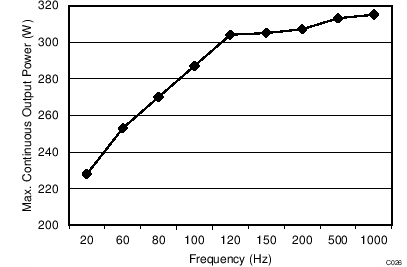SLASEM8A January 2019 – March 2019 TPA3255-Q1
PRODUCTION DATA.
- 1 Features
- 2 Applications
- 3 Description
- 4 Revision History
- 5 Pin Configuration and Functions
-
6 Specifications
- 6.1 Absolute Maximum Ratings
- 6.2 ESD Ratings
- 6.3 Recommended Operating Conditions
- 6.4 Thermal Information
- 6.5 Electrical Characteristics
- 6.6 Audio Characteristics (BTL)
- 6.7 Audio Characteristics (SE)
- 6.8 Audio Characteristics (PBTL)
- 6.9 Typical Characteristics, BTL Configuration
- 6.10 Typical Characteristics, SE Configuration
- 6.11 Typical Characteristics, PBTL Configuration
- 7 Parameter Measurement Information
-
8 Detailed Description
- 8.1 Overview
- 8.2 Functional Block Diagrams
- 8.3 Feature Description
- 8.4
Device Functional Modes
- 8.4.1
Device Protection System
- 8.4.1.1 Overload and Short Circuit Current Protection
- 8.4.1.2 Signal Clipping and Pulse Injector
- 8.4.1.3 DC Speaker Protection
- 8.4.1.4 Pin-to-Pin Short Circuit Protection (PPSC)
- 8.4.1.5 Overtemperature Protection OTW and OTE
- 8.4.1.6 Undervoltage Protection (UVP) and Power-on Reset (POR)
- 8.4.1.7 Fault Handling
- 8.4.1.8 Device Reset
- 8.4.1
Device Protection System
- 9 Application and Implementation
- 10Power Supply Recommendations
- 11Layout
- 12Device and Documentation Support
- 13Mechanical, Packaging, and Orderable Information
Package Options
Mechanical Data (Package|Pins)
- DDV|44
Thermal pad, mechanical data (Package|Pins)
- DDV|44
Orderable Information
10.4.2 Thermal Performance with Continuous Output Power
It is recommended to operate TPA3255-Q1 below the OTW threshold. In most systems normal use conditions will safely keep the device temperature with margin to the OTW threshold. However in some systems and use cases the device tempertaure can run high, dependent on the actual output power, operating voltage, and thermal system. At high operating temperature some thermal limitations for continuous output power may occur at low audio frequencies due to increased heating of the output MOSFETs. Figure 33 shows maximum attainable continuous output power with a heatsink temperature of 75ºC and maximum 10% THD.
 Figure 33. Maximum Continuous Output Power vs Frequency, BTL, 4Ω Load, Each Channel, TC = 75°C
Figure 33. Maximum Continuous Output Power vs Frequency, BTL, 4Ω Load, Each Channel, TC = 75°C